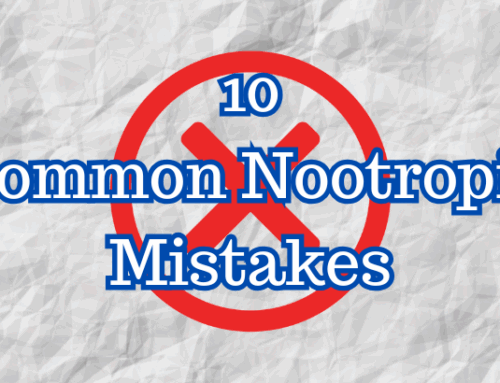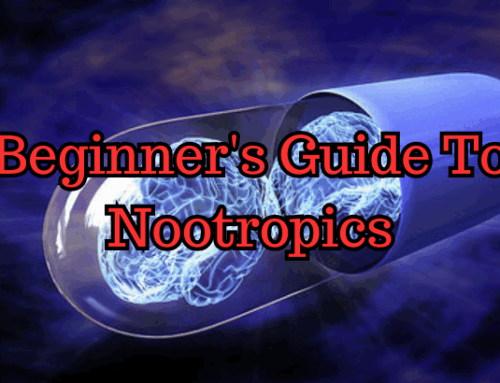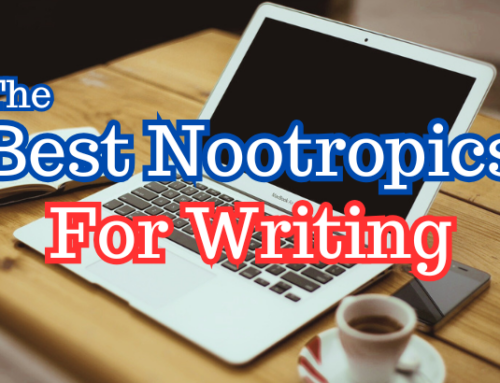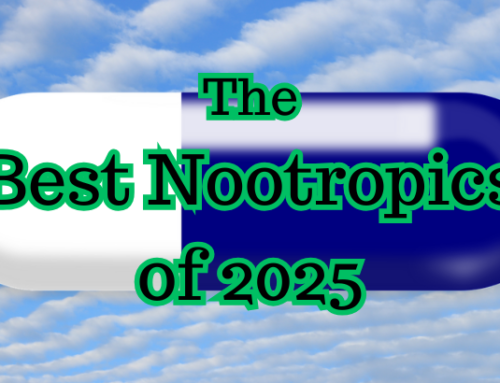There are a lot of nootropics that have more than one potential benefit. Take aniracetam, for example. Not only does it have the potential to improve cognition, it can also reduce anxiety. Or take modafinil. Modafinil users often report that it increases wakefulness while increasing focus at the same time. It's not uncommon for nootropics to have multiple benefits.
One nootropic that has an incredibly varied set of potential benefits is vinpocetine. This interesting supplement can potentially improve mood, hearing, vision, cardiovascular health, and even seems to have anti-inflammatory effects.
In this article, we're going to take an in-depth look at vinpocetine. We'll examine its potential benefits, negative effects, dosage, where to buy, and more. But first, let's see exactly what vinpocetine is.
What Is Vinpocetine?
This interesting substance is known to have a number of medicinal properties. Vinpocetine has been used medically in parts of Europe for over thirty years.1 It is a synthetic compound but derived from the seeds and leaves of the Periwinkle plant.2 Vinpocetine was first isolated from the Periwinkle plant by Hungarian chemist Csaba Szantay in 1975.3 By 1978 it was already being mass-produced by the Hungarian pharmaceutical company Richter Gedeon.4
In some European countries, vinpocetine is a prescription medication. It is used to treat a number of different conditions including cerebrovascular disorders like stroke and dementia.5 In Germany, for example, vinpocetine is a prescription drug sold under the brand name Cavinton.6 Other brand names for vinpocetine include Intelectol, Cognitol, and Neurovin.7
This fascinating substance has been scientifically shown to have a number of effects on the body and brain. Vinpocetine's nootropic benefits are likely due, at least in part, to its ability to selectively inhibit voltage-sensitive sodium channels and decrease calcium ions in striatal nerve endings.8 As a sodium channel inhibitor, vinpocetine is thought to have a general neuroprotective effect by blocking excitotoxicity and has been shown to reduce neuronal damage from cerebral ischemia (reduced blood flow to the brain).9
 Vinpocetine is known to affect a number of neurotransmitters that are known to play a role in memory, focus, motivation, pleasure, reward, anxiety, and more. It has been shown to have an effect on the neurotransmitters norepinephrine (noradrenaline),10 dopamine,11 glutamate,12 and gamma-aminobutyric acid (GABA).13
Vinpocetine is known to affect a number of neurotransmitters that are known to play a role in memory, focus, motivation, pleasure, reward, anxiety, and more. It has been shown to have an effect on the neurotransmitters norepinephrine (noradrenaline),10 dopamine,11 glutamate,12 and gamma-aminobutyric acid (GABA).13
In addition to its nootropic benefits which we'll go over shortly, vinpocetine also has several effects on the body. One of these effects is vasodilation. Vinpocetine has been shown to be a vasodilator and has been studied in stroke victims because of this effect.14 It has also been shown to have anticonvulsant properties in animal studies.15 Lastly, vinpocetine has been shown to have antiinflammatory properties, including the ability to reduce neuroinflammation.16
Now that we've taken a look at what vinpocetine is, let's discuss its potential nootropic benefits. We'll see what people are saying about vinpocetine and dive into the scientific research that has been done on this Periwinkle-plant-derived substance.
Vinpocetine Nootropic Benefits
In addition to having a number of potential physical benefits, people from all around the world have reported nootropic effects from taking vinpocetine. Here are some of the reported nootropic benefits of taking vinpocetine and the science to support these claims.
Improved Memory

One of the most-commonly-reported nootropic benefits of vinpocetine is improved memory. Users often say they find it easier to memorize and recall information when supplementing with vinpocetine. And there is a bit of science to support this claim.
A study done back in 1985 looked at the effect vinpocetine had on healthy female volunteers.17 The women were given either vinpocetine or a placebo. While the women in the placebo group did not show any changes on any of the tests the researchers had them perform, the women in the vinpocetine group did. These women showed significant improvements on all the memory tests they were given.
Another study done on healthy human volunteers from 2001 looked at the effect vinpocetine and another nootropic, ginkgo biloba, had on memory.18 Participants were either given a placebo or a capsules containing both ginkgo biloba and vinpocetine. The results of this study found that the participants in the ginkgo/vinpocetine group showed a significant improvement in short-term working memory processing while those in the placebo group did not.
In addition to human studies demonstrating vinpocetine's memory-improving effects, a number of animal studies have also been performed. A 1986 study looked at the effect vinpocetine would have on rats with drug-induced (scopolamine) or hypoxia-induced (lack of oxygen) memory deficits.19 The results showed that vinpocetine significantly improved the rats' memory in both groups.
Vinpocetine's memory-boosting benefits have been well documented. It has even been shown to improve cognitive impairment caused by flunitrazepam. More commonly known by the brand name Rohypnol (or roofies for short), flunitrazepam is often referred to as the date rape drug. The results of a 1987 study showed that vinpocetine improved short-term memory in healthy volunteers who had been given flunitrazepam.20
While memory improvement is the most researched nootropic benefit of vinpocetine, it's not the only one. Users also often report an increase in focus and attention.
Increased Focus and Attention

Another nootropic benefit that is often reported from taking vinpocetine is increased attention and focus. This benefit hasn't been studied nearly as much as improved memory, but there has been some research done to support this claim.
The 1985 study mentioned above that looked at vinpocetine's effect on memory also looked at its ability to affect processing speed and attention.17 The researchers found that, at a dosage of 40 milligrams (mg) per day, vinpocetine was able to reduce reaction time and improve memory.
A more-recent human study was done to see if vinpocetine and other substances could reverse brain damage in football players.21 In this 2011 study, former NFL players were given a combination of supplements (one of which was vinpocetine) to see what effect it had on their memory, focus, attention, and other aspects of cognitive functioning. The results showed that the players had significant improvements in focus, attention, memory, and other areas of cognition. While it's not clear exactly what role vinpocetine played in the players' improvements, these results are encouraging.
Some animal studies have also supported the claim that vinpocetine can increase focus and attention. A 2011 study looked at the effect vinpocetine had on hyperactive rats.22 The researchers induced hyperactivity in the rats by using ethanol and then they administered vinpocetine to the animals. The results showed that vinpocetine administration significantly decreased hyperactivity in the rats.
While more human studies are needed before it can conclusively be stated that vinpocetine increases focus and attention, the studies that have been done are very promising.
Overall Cognitive Enhancement

A lot of vinpocetine users claim that it improves general cognition. I've heard people claim that it helps them to think clearer, faster, and more productively. In addition to the studies noted above that have shown improvements in specific areas of cognition, other studies have concluded that vinpocetine is a general cognitive enhancer.
A study published in 1987 looked at the safety and effectiveness of vinpocetine in the treatment of patients with cerebral (brain) dysfunction.23 In addition to improving a number of physical things like muscle strength, function, and coordination, this study showed that vinpocetine also significantly improved overall cognition. Additionally, the researchers found vinpocetine to be free of any serious side effects.
In addition to being a vasodilator, vinpocetine has also been shown to increase blood flow to the brain.24 This may account for some of vinpocetine's general nootropic effects. A 2005 study showed that both short-and-long-term vinpocetine administration improved blood flow and cognition in patients with multiple cerebral infarcts.25 The researchers also noted that the participants had no serious side effects and that vinpocetine was safe for long-term use.
After over three decades of research, it's clear that vinpocetine can improve at least some aspects of cognitive performance. And it also seems to be very safe for most people. Let's take a closer look at vinpocetine's safety.
Vinpocetine Negative Effects & Safety
![]() Vinpocetine seems to be very well tolerated in humans and no serious negative effects have been noted in clinical trials.26 In the human studies mentioned above that explored vinpocetine's safety, it was found to be free of any serious unwanted effects.2325
Vinpocetine seems to be very well tolerated in humans and no serious negative effects have been noted in clinical trials.26 In the human studies mentioned above that explored vinpocetine's safety, it was found to be free of any serious unwanted effects.2325
While negative effects from vinpocetine are rare and usually mild, they may include nausea, dizziness, flushing, drowsiness, insomnia, anxiety, dry mouth, and upset stomach.27 Since vinpocetine has not been studied in children, pregnant women, or nursing mothers, it probably shouldn't be used by these populations.
Vinpocetine Dosage/How To Take
![]()
The human studies mentioned above used daily dosages of vinpocetine ranging from 10-60 mg, usually divided into 2-3 doses. When used for nootropic purposes, some users report vinpocetine being effective at as little as 20 mg a day. However, many users report that they need 40 mg a day or more to notice its nootropic benefits.
As with any drug or supplement, you should always start at the low end of the dosage spectrum and work your way up as needed. Long-term use of dosages above 40 mg a day have not been studied. However, there are numerous anecdotal reports around the internet of people using much higher dosages for long periods of time with no serious negative effects.
If you experience any unwanted effects, they should go away quickly after you stop taking vinpocetine. To reduce the possibility of upset stomach and increase the body's absorption of vinpocetine, it should be taken with a small meal. Taking vinpocetine with food may increase its bioavailability by between 60-100% compared to taking it on an empty stomach.28
As with any time you start taking a new supplement, medication, or plant, or begin a new exercise program or behavioral routine, it's always a good idea to consult with a licensed medical professional first. This is especially true if you're on any prescription medications. That being said, most doctors don't know very much about nootropics. So, you may have to educate yours a bit. The References section toward the bottom of this page is a good place to start.
Where To Buy Vinpocetine

If you're looking to buy vinpocetine tablets or buy it in powder form, Pure Rawz offers both. They have established themselves as one of the best nootropic companies around. Pure Rawz has an astonishing selection of high-quality products, reasonable prices, discreet shipping, and good customer service. Just be aware that the vinpocetine tablets Pure Rawz offers seem to be dosed quite high at 150 mg each, so you may want to break them into quarters when starting out. If you order from Pure Rawz, you can save 10% off your order by using the code nz10 at the checkout.
Another nootropic vendor that offers vinpocetine in capsule form is Pure Nootropics. Their capsules contain 20 mg of vinpocetine each. Pure Nootropics has been around for years and, although their selection is quite limited, is among the highest-rated nootropic vendors. They have great products, good prices, fast and discreet shipping, and excellent customer service.
Conclusion
 Vinpocetine is an interesting substance with a number of potential nootropic benefits. Lots of people have reported that it helps them to focus, remember things better, and be more productive overall. And there's plenty of science to support both vinpocetine's effectiveness and safety. It's been around for decades and has been the subject of several clinical trials around the world.
Vinpocetine is an interesting substance with a number of potential nootropic benefits. Lots of people have reported that it helps them to focus, remember things better, and be more productive overall. And there's plenty of science to support both vinpocetine's effectiveness and safety. It's been around for decades and has been the subject of several clinical trials around the world.
Have you tried vinpocetine? If so, what has your experience with it been like? Please leave your answer in the comments section at the bottom of the page. And if you haven't already, sign up for the Nootropics Zone mailing list below to learn about dozens of brain-boosting substances.
To learn more about nootropics, sign up for the Nootropics Zone newsletter. You'll get the free gift, The Ultimate Nootropics Quick Reference Guide.
References
1Zhang, Y., Li, J., & Yan, C. (2018). An update on vinpocetine: new discoveries and clinical implications. European Journal of Pharmacology, 819:30-4.
2Vinpocetine. (n.d.). Examine.com. Retrieved March 15, 2024 from https://examine.com/supplements/vinpocetine/
3Lorincz, C., Szasz, K., & Kisfaludy, L. (1976). The synthesis of ethyl apovincaminate. Arzneimittelforschung, 26(10a):1907.
4Vinpocetine. (n.d.). Wikidoc.org. Retrieved March 15, 2024 from https://www.wikidoc.org/index.php/Vinpocetine
5Vinpocetine. (n.d.). Wikipedia.org. Retrieved March 15, 2024 from https://en.wikipedia.org/wiki/Vinpocetine
6Vinpocetine. (n.d.). WebMD. Retrieved September 11, 2020 from https://www.webmd.com/vitamins/ai/ingredientmono-175/vinpocetine
7Vinpocetine price of 3 brands. (2017, Feb. 2). MedIndia.net. Retrieved September 11, 2020 from https://www.medindia.net/drug-price/vinpocetine.htm
8Sitges, M., Galvan, E., & Nekrassov, V. (2005). Vinpocetine blockade of sodium channels inhibits the rise in sodium and calcium induced by 4-aminopyridine in syaptosomes. Neurochemistry International, 46(7):533-40.
9Adam-Vizi, V. (2000). Neuroprotective effect of sodium channel blockers in ischemia: the pathomechanism of early ischemic dysfunction. Orvosi Hetilap, 141(23):1279-86.
10Gaal, L, & Molnar, P. (1990). Effect of vinpocetine on noradrenergic neurons in rat locus coeruleus. European Journal of Pharmacology, 187(3):537-9.
11Trejo, F., Nekrassov, V., & Sitges, M. (2001). Characterization of vinpocetine effects on DA and DOPAC release in striatal isolated nerve endings. Brain Research, 909(1-2):59-67.
12Kiss, B., Cai, N., & Erdo, S. (1991). Vinpocetine preferentially antagonizes quisqualate/AMPA receptor responses: evidence from release and ligand binding studies. European Journal of Pharmacology, 209(1-2):109-12.
13Gulyas, B., Halldin, C., Karlsson, P., Chou, Y., Swahn, C., Bonock, P., Paroczai, M., & Farde, L. (1999). Brain uptake and plasma metabolism of [11C]vinpocetine: a preliminary PET study in a cynomolgus monkey. Journal of Neuroimaging, 9(4):217-22.
14Bereczki, D., Fekete, I., & Cochrane Stroke Group. (2008). Vinpocetine for acute ischaemic stroke. Cochrane Database of Systematic Reviews, 2008(1).
15Sitges, M., Sanchez-Tafolla, B., Chiu, L., Aldana, B., & Guarneros, A. (2011). Vinpocetine inhibits glutamate release induced by the convulsive agent 4-aminopyridine more potently than several antiepileptic drugs. Epilepsy Research, 96(3):257-66.
16Medina, A. (2010). Vinpocetine as a potent antiinflammatory agent. Proceedings of the National Academy of Sciences of the United States of America, 107(22):9921-2.
17Subhan, Z., & Hindmarch, I. (1985). Psychopharmacological effects of vinpocetine in normal healthy volunteers. European Journal of Clinical Pharmacology, 28(5):567-71.
18Polich, J., & Gloria, R. (2001). Cognitive effects of a ginkgo biloba/vinpocetine compound in normal adults: systematic assessment of perception, attention, and memory. Human Psychopharmacology, 16(5):409-16.
19DeNoble, V., Repetti, S., Gelpke, L, Wood, L., & Keim, K. (1986). Vinpocetine: nootropic effects on scopolamine-induced and hypoxia-induced retrieval deficits of a step-through passive avoidance response in rats. Pharmacology, Biochemistry, and Behavior, 24(4):1123-8.
20Bhatti, J., & Hindmarch, I. (1987). Vinpocetine effects on cognitive impairments produced by flunitrazepam. International Clinical Psychopharmacology, 2(4):325-31.
21Amen, D., Wu, J., Taylor, D., & Willeumier, K. (2011). Reversing brain damage in former NFL players: implications for traumatic brain injury and substance abuse rehabilitation. Journal of Psychoactive Drugs, 43(1):1-5.
22Nunes, F., Ferreira-Rosa, K., Pereira, M., Kubrusly, R., Manhaes, A., Abreu-Villaca, Y., & Filgueiras, C. (2011). Acute administration of vinpocetine, a phosphodiesterase type 1 inhibitor, ameliorates hyperactivity in a mice model of fetal alcohol spectrum disorder. Drug and Alcohol Dependence, 119(1-2):81-7.
23Balestreri, R., Fontana, L., & Astengo, F. (1987). A double-blind placebo controlled evaluation of the safety and efficacy of vinpocetine in the treatment of of patients with chronic vascular senile cerebral dysfunction. Journal of the American Geriatrics Society, 35(5):425-30.
24Lim, C., Cook, P., & James, I. (1980). The effect of an acute infusion of vincamine and ethyl apovincaminate. British Journal of Clinical Pharmacology, 9(1):100-1.
25Kemeny, V., Molnar, S., Andrejkovics, M., Makai, A., & Csiba, L. (2005). Acute and chronic effects of vinpocetine on cerebral hemodynamics and neuropsychological performance in multi-infarct patients. Journal of Clinical Pharmacology, 45(9):1048-54.
26Vinpocetine side effects and warnings. (n.d.). Found Health. Retrieved September 11, 2020 from http://www.foundhealth.com/vinpocetine/side-effects-and-warnings
27Wong, C. (2020, Aug. 12). Health benefits of vinpocetine: popular fat burner and memory booster stirs controversy. VeryWellHealth.com.
28Lohmann, A., Dingler, E., Sommer, W., Schaffler, K., Wober, W., & Schmidt, W. (1992). Bioavailability of vinpocetine and interference of the time of application with food intake. Arzneimittelforschung, 42(7):914-7.
[This article was originally published on July 11, 2015. Updated March 15, 2024.]







I’ve been using this successfully since the publication of the reference #21 above, along with the other items in that study some of which I’ve used much longer. In addition to post-concussion help, I’ve learned that they are extremely helpful for the effects of neuroborreliosis, aka Lyme disease.
That’s wonderful that you’ve had success with vinpocetine! I’ve heard similar stories about it from a few people now.